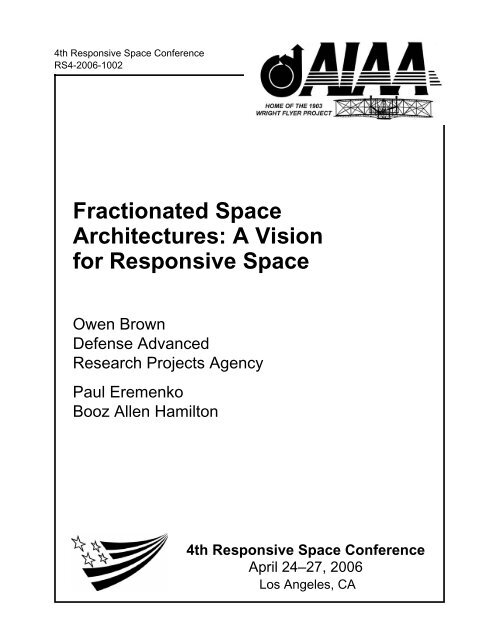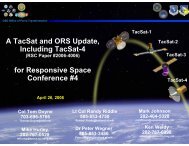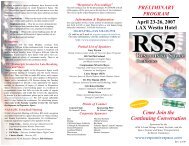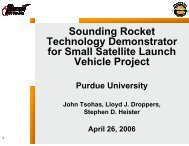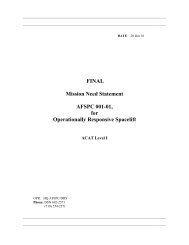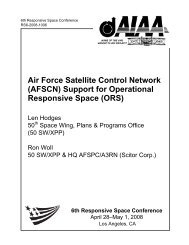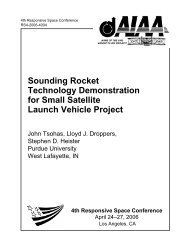Fractionated Space Architectures: A Vision for Responsive Space
Fractionated Space Architectures: A Vision for Responsive Space
Fractionated Space Architectures: A Vision for Responsive Space
You also want an ePaper? Increase the reach of your titles
YUMPU automatically turns print PDFs into web optimized ePapers that Google loves.
4th <strong>Responsive</strong> <strong>Space</strong> Conference<br />
RS4-2006-1002<br />
<strong>Fractionated</strong> <strong>Space</strong><br />
<strong>Architectures</strong>: A <strong>Vision</strong><br />
<strong>for</strong> <strong>Responsive</strong> <strong>Space</strong><br />
Owen Brown<br />
Defense Advanced<br />
Research Projects Agency<br />
Paul Eremenko<br />
Booz Allen Hamilton<br />
4th <strong>Responsive</strong> <strong>Space</strong> Conference<br />
April 24–27, 2006<br />
Los Angeles, CA
FRACTIONATED SPACE ARCHITECTURES:<br />
A VISION FOR RESPONSIVE SPACE *<br />
O. Brown **<br />
Defense Advanced Research Projects Agency<br />
P. Eremenko †<br />
Booz Allen Hamilton<br />
We propose a definition <strong>for</strong> responsive space that encompasses the speed with<br />
which a space system – broadly defined – can be made to react to various <strong>for</strong>ms<br />
of uncertainty, ranging from geopolitical operational requirements to technical<br />
failures to fluctuations in the acquisition funding stream. We note that the everlarger<br />
monolithic spacecraft of today are notoriously unresponsive. We then<br />
suggest a novel architectural paradigm, which we call fractionated spacecraft,<br />
whereby a satellite is decomposed into a set of similar or dissimilar component<br />
modules which interact wirelessly while in cluster orbits. A perfunctory survey<br />
of enabling technologies and an overview of the objectives of the <strong>for</strong>thcoming<br />
System F6 initiative at DARPA is provided. Given our more <strong>for</strong>mal definition of<br />
responsiveness and this new proposed architecture, we conclude that spacecraft<br />
fractionation results in responsiveness across all possible scales of spacecraft size,<br />
including very large spacecraft systems that are only made possible by<br />
fractionation.<br />
<strong>Responsive</strong> <strong>Space</strong><br />
THE PROBLEM<br />
What is responsive space? Conventional wisdom suggests that it is the ability to<br />
quickly develop and launch orbital payloads. We disagree with this narrow<br />
view. Although shortening the development and launch timelines is one<br />
instantiation of the solution, we understand the broader definition of responsive<br />
space as this:<br />
<strong>Responsive</strong> space is the capability of space systems to respond rapidly to<br />
uncertainty.<br />
This broadens the solution space; it permits us to consider alternate – and<br />
undoubtedly complementary – means of enabling responsiveness across a wide<br />
range of systems, large and small. The conventional view of responsive space is<br />
* This paper is declared a work of the U.S. Government and is not subject to copyright protection<br />
in the United States. Approved <strong>for</strong> public release. Distribution unlimited.<br />
** Program Manager, Tactical Technology Office. E-mail: owen.brown@darpa.mil.<br />
† Associate, Defense Business Segment. E-mail: eremenko_paul@bah.com.<br />
- 1 -
predicated on one manifestation of uncertainty: that of a combatant commander<br />
faced with a temporally and geographically uncertain threat. Hence, resultant<br />
ef<strong>for</strong>ts focus on the need <strong>for</strong> launch on demand in response to a particular<br />
tactical threat, at a specific location and on short notice. But there are other<br />
manifestations of uncertainty which vex not only the warfighter in the field, but<br />
also the acquisition official, the spacecraft designer, manufacturer, tester, and<br />
operator. Uncertainty exists throughout the entire lifecycle of a space system, and<br />
there<strong>for</strong>e the need <strong>for</strong> responsiveness is omnipresent from cradle to grave.<br />
With this expansive notion of responsiveness in mind, we introduce a novel<br />
architecture developed by the Defense Advanced Research Projects Agency<br />
(DARPA) which we term fractionated spacecraft. This approach to spacecraft<br />
design promises to affect responsiveness not just by shrinking spacecraft<br />
development timelines and enabling launch with smaller, more tactical vehicles,<br />
but also by making the spacecraft architecture fundamentally flexible and robust.<br />
We show that this makes a satellite able to adjust to uncertainty throughout its<br />
lifecycle. DARPA’s System F6 – Future Fast, Flexible, Free-Flying, <strong>Fractionated</strong><br />
<strong>Space</strong>craft united by In<strong>for</strong>mation eXchange – is a technological and paradigmatic<br />
demonstrator of the responsive nature of fractionated satellites; the specific<br />
objectives of System F6 are discussed in later sections of this paper. But first, we<br />
turn to a brief discussion of the uncertainties faced by space systems throughout<br />
their lifecycle, and the present approaches to coping with them with the intent of<br />
identifying the potential <strong>for</strong> improved flexibility, robustness, and hence<br />
responsiveness.<br />
Sources of Uncertainty<br />
It is not enough <strong>for</strong> a spacecraft to deliver a given capability – it must do so with<br />
flexibility and robustness in the face of various sources of risk and opportunity. 1<br />
As we noted above, the speed with which a space system can react or adapt to<br />
uncertainty is the measure of its responsiveness. Below we consider some of the<br />
major sources of uncertainty that arise throughout the development and<br />
operation of a typical spacecraft. Conventional methods of dealing with such<br />
uncertainties are provided.<br />
Technical Uncertainty: We categorize those risk sources which are endogenous to<br />
the spacecraft during operations as technical risks. 2 Examples would be a<br />
1 We use the terms risk and opportunity interchangeably with uncertainty. We tend to use risk to<br />
describe fluctuations in some parameter (either exogenous or endogenous to the system) that<br />
tend to lead to degradation in system per<strong>for</strong>mance, cost, value, schedule, or some other metric.<br />
Opportunity refers to parameter fluctuations that can produce an improvement in some metric of<br />
per<strong>for</strong>mance.<br />
2 The distinction between such endogenous failures and exogenous environmental factors is<br />
admittedly blurry. For instance an internal component generally fails only due to some external<br />
- 2 -
component failure, a software bug, a design flaw, or an erroneous command (if<br />
the operator is construed to be part of the spacecraft system). Such technical risks<br />
can negatively affect the capability or per<strong>for</strong>mance of the satellite, thereby<br />
undermining the value delivered, increase cost, or slip schedule. An example of a<br />
technical opportunity is the development of a new component capability, <strong>for</strong><br />
instance vastly improved processor speed, that could be inserted into a system at<br />
some time after its launch.<br />
Current conventional capability to address risks associated with on orbit<br />
operations is very constrained. On orbit degradations and failures can sometimes<br />
be addressed through software patches or novel operations. 3 Systematic<br />
architectural solutions to repair and/or replace failed or degraded systems<br />
onboard spacecraft are rare, and can be found on only one spacecraft, the Hubble<br />
<strong>Space</strong> Telescope. Hubble servicing missions using the <strong>Space</strong> Shuttle and trained<br />
astronaut crews require extensive planning and training, and consequently are<br />
not responsive. DARPA’s Orbital Express (OE) program is intended to<br />
demonstrate the capabilities of unmanned robotic servicing, thus providing a<br />
new method to responsively address technical risk (without risk to humans). A<br />
second means to address technical risk in a rapid manner is through the use of<br />
on-orbit spares. Currently though, the overwhelming majority of space systems<br />
address operational risk through prevention and redundancy, i.e., quality and<br />
reliability. This has led to unintended consequences, especially <strong>for</strong> large<br />
spacecraft. Since failure is not acceptable, reliability is addressed by a high<br />
degree of redundancy. The impact is to make an already complex engineering<br />
system even larger and more complex. Quality control focuses on rigorous<br />
inspections and lengthy testing programs. With the exception of the on-orbit<br />
servicing architecture offered by OE and the maintenance of expensive on-orbit<br />
spares, none of the a<strong>for</strong>ementioned methods of addressing technical risk offers<br />
the potential <strong>for</strong> responsiveness.<br />
Environmental Uncertainty: Variations beyond some nominal range in the<br />
environmental conditions during spacecraft operations, including temperature,<br />
radiation levels, space object impact, etc., would constitute environmental risks.<br />
Analogously to technical risks, environmental risk factors can adversely affect<br />
stimulus. We loosely categorize those failures which occur under nominal environmental<br />
conditions as endogenous, and those triggered by unusual environmental variations as<br />
exogenous. This categorization, however, is of no importance to our argument. Also, note that we<br />
are not referring to technical risk during the development phase – the risk that an unproven<br />
technology will not come to fruition. We associate such risk with requirements uncertainty.<br />
3 An example includes utilization of the low data rate antenna together with advanced data<br />
processing techniques <strong>for</strong> science return on the Galileo spacecraft after the high gain antenna<br />
failed to deploy (see http://www2.jpl.nasa.gov/galileo/anomaly.html). Another example is that<br />
of GOES-10, which was flipped upside down to enable its solar array to rotate in the opposite<br />
direction, after it was found the array become stuck while commanded to rotate in the intended<br />
direction (see http://goes.gsfc.nasa.gov/text/goeskstatus.html).<br />
- 3 -
the capability or per<strong>for</strong>mance of the spacecraft, potentially reducing the value it<br />
delivers. It is difficult to proffer environmental uncertainties which provide<br />
opportunity. 4<br />
The conventional methods to address environmental uncertainties are very<br />
similar to those <strong>for</strong> technical uncertainties as described, i.e., through prevention<br />
and redundancy. Prevention is mainly handled by large design margins,<br />
especially in radiation hardness. Again, these preventative and design<br />
techniques offer little recourse if damage or failure due to environmental factors<br />
does occur. Only an on-orbit servicing architecture can truly react to such risks<br />
quickly.<br />
Launch Uncertainty: Although launch failure risk itself can be seen as composed<br />
of various factors which may be endogenous or exogenous to the launch vehicle<br />
system, from the spacecraft perspective they can all be aggregated into the<br />
uncertainty in reaching the desired orbit. Failure to do so can have an adverse<br />
effect on the satellite value stream (as well as schedule and cost, if a replacement<br />
must be launched). An example of launch vehicle uncertainty resulting in<br />
opportunity is the market introduction of a new launch vehicle that could be<br />
utilized to diversify risk or enable more responsive launch.<br />
The current method of dealing with launch vehicle risk is once again mainly by<br />
prevention, with intensive mission success programs. Commercial operators also<br />
address launch risk by purchasing insurance, which typically runs 10% to 20% of<br />
spacecraft value. Military missions, although self-insured in an economic sense,<br />
frequently necessitate the availability of a rather expensive on the ground<br />
“spare” to ensure mission success in the event of a launch failure.<br />
Should failure occur – and it does – the costs are extreme, both in terms of money<br />
and underserved markets. In the case of DOD or civil losses, failure results in lost<br />
capability or lost science. The time to recover from such catastrophe, especially<br />
<strong>for</strong> large spacecraft, is substantial. Opportunities brought on by the introduction<br />
of new launch vehicles are limited, being available only if that vehicle has the<br />
capacity to launch a current design. Altogether, responsiveness to launch risk in<br />
today’s space system can be seen to be poor.<br />
Demand Uncertainty: Here we refer to the demand <strong>for</strong> the capability or service<br />
provided by the spacecraft during its operational life. Demand fluctuations can<br />
occur due to a variety of factors including a change in user constituency,<br />
competing providers of the same service, or obsolescence. Demand volatility<br />
impacts the value delivered by the spacecraft. Initial demand below the full<br />
capacity of the spacecraft design can be categorized as demand risk, while<br />
4 An aerospace example of an environmental opportunity would be atmospheric thermals, which<br />
can be exploited by birds or glider pilots to increase endurance.<br />
- 4 -
increases in demand (above the full capacity of the spacecraft design) can be<br />
construed as demand opportunities. Quick reaction to demand uncertainty in<br />
today’s space system architectures is currently viewed as the “niche” application<br />
of responsive space. Specifically, responsive space is seen as a response to threats<br />
that will appear at currently unknown place sometime in the future. In other<br />
more conventional (i.e., not responsive) spacecraft architectures, demand<br />
uncertainties are not addressed in a rapid manner. If a sufficient increase in<br />
demand is experienced, additional spacecraft are developed and deployed in<br />
timelines that are not particularly quick. Demand risk is accepted as just that –<br />
risk, with no current systematic way provided to first test markets be<strong>for</strong>e rolling<br />
out full capability.<br />
Requirements Uncertainty: Risk related to uncertainty in requirements comes in<br />
two <strong>for</strong>ms. First, there is risk due to changing requirements during a design<br />
cycle. Requirement changes throughout the development of a spacecraft can<br />
necessitate design changes with associated cost, schedule, and value penalties.<br />
Second, there is risk due to requirements causing coupled interactions between<br />
payloads and/or bus elements. This is especially true with large spacecraft<br />
where multiple requirements create a systems engineering nightmare. For<br />
example, take a spacecraft with two sensors. One stares, with very rigid pointing<br />
requirements. The second sensor rotates. Dynamic interaction between the two<br />
sensors, as well as a large spacecraft bus structure susceptible to thermal<br />
distortions, creates a difficult engineering problem. There is no systematic<br />
approach currently in use <strong>for</strong> addressing requirements risk. Requirements<br />
uncertainty can lead to opportunity. For instance, if a space system has sufficient<br />
flexibility to test and demonstrate a new capability, a new requirement can be<br />
created to fund future operational systems with that capability.<br />
Funding Stream Uncertainty: Due to competing program budget priorities, the<br />
available funding <strong>for</strong> the development of a particular system, can fluctuate in a<br />
quasi-random manner due to in innumerable factors. Funding stream risk can,<br />
and typically is, fatal to many systems since most space systems are deeply<br />
integrated and their per<strong>for</strong>mance not easily scalable (especially in the downward<br />
direction). Funding stream opportunities could occur if a program is given high<br />
prioritization and there<strong>for</strong>e more funding. Given the “craft” nature of the space<br />
industry today, programs are in reality hard-pressed to effectively and efficiently<br />
capitalize by offering more capability per unit time. In other words, the<br />
“production line” is hard to speed up, because it does not effectively exist.<br />
As described above, currently no systematic means <strong>for</strong> addressing uncertainty<br />
from all sources and throughout all phases of conventional spacecraft<br />
development and operations is employed. Today’s space systems are thus<br />
limited in their responsiveness. This is true <strong>for</strong> all sizes of spacecraft, but<br />
especially so <strong>for</strong> large spacecraft. Why is this so? The short answer is because the<br />
- 5 -
problem of identifying and designing <strong>for</strong> responsiveness to a multitude of<br />
sources of uncertainty is intractably complicated and expensive. The history of<br />
various complex engineered systems has been marred by the phenomenon of<br />
cost-complexity death spirals. <strong>Space</strong>craft have been no exception. Whereas in<br />
principle the complexity and the cost of an engineering system should scale<br />
roughly in proportion to the system’s capability, in practice this is almost never<br />
the case. The assured delivery of the capability necessitates making the system<br />
flexible and robust to various uncertainties. The array of uncertainties and failure<br />
modes itself grows with the system’s complexity, and the mechanisms (the most<br />
common being design margins and redundancy) to address these potential<br />
failure modes add to it, with the resultant effect of making overall system<br />
complexity grow exponentially. The system’s cost follows suit.<br />
While engineers are trained to mitigate many sources of uncertainty in system<br />
design through redundancy, and while acquisition officials attempt to<br />
compensate <strong>for</strong> other sources through stringent contracting oversight and<br />
insurance, there is no cogent architectural framework <strong>for</strong> identifying and<br />
quantifying risk and opportunity sources and implementing optimal strategies<br />
<strong>for</strong> addressing either.<br />
Today’s spacecraft are designed <strong>for</strong> requirements. A more responsive solution is<br />
to design spacecraft <strong>for</strong> uncertainty.<br />
The requirements-centric paradigm, together with a minimum-cost acquisition<br />
mindset has had negative consequences, having led system architects and<br />
decision-makers to reach the erroneous conclusion that the answer to cost<br />
growth is greater capability and/or increased lifetimes. 5 Consequently, longer<br />
lifetimes, more transponders per satellite, and multi-functional payloads have all<br />
been touted as panacea <strong>for</strong> the rising cost problem. Unsurprisingly, longer<br />
lifetimes have levied additional requirements in the face of system obsolescence,<br />
additional capability has led to bigger satellites posing commensurately harder<br />
integration, testing, and launch problems, and multi-functional payloads have<br />
imposed the most stringent payload pointing and isolation environments across<br />
the entire system. The consequence, unsurprisingly, has been further cost growth<br />
and less responsiveness to the various <strong>for</strong>ms of uncertainty.<br />
Perhaps an even more sinister byproduct of rising system complexity is fragility.<br />
Fragility is the tendency of complex systems to exhibit “emergent” – i.e., unmodeled<br />
– failure modes, usually due to an unanticipated component interaction<br />
leading to a highly improbable but catastrophic sequence of events. Whereas a<br />
complex system can be made robust by anticipating uncertainty and designing<br />
5 See, e.g., Saleh, J., “Flawed metrics*: satellite cost per transponder and cost per operational day<br />
(*<strong>for</strong> guiding design decisions),” IEEE Transactions on Aerospace and Electronic Systems (accepted),<br />
2006.<br />
- 6 -
<strong>for</strong> it, fragility tends to rear its ugly head in the most robust, scrupulously<br />
designed, and meticulously tested of systems. One need only look to the Apollo<br />
13, Challenger, or Columbia accidents <strong>for</strong> examples.<br />
Is this cost-complexity death spiral in spacecraft avoidable? Is uncertainty (and<br />
fragility) a manageable phenomena? Can satellites of all sizes be designed<br />
“ground up” with uncertainty in mind? We believe the answer is answer to all of<br />
these questions is a resounding “yes.” Prerequisite, however, is a trans<strong>for</strong>mation<br />
from the gargantuan monolithic spacecraft of today to distributed networks of<br />
small fractionated spacecraft components.<br />
The Concept of Free Flying Fractionation<br />
THE RESPONSIVE SOLUTION<br />
A new space system engineering architecture is now introduced which in fact<br />
provides a means to design <strong>for</strong> uncertainty. This concept is that of free flying<br />
fractionation. We use “fractionation” as a term of art to describe the<br />
decomposition of a system into distinct modules which once “assembled” on<br />
orbit deliver the capability of the original monolithic system. Previous and<br />
existing concepts exist which envision “lego block,” “plug-and-play,” and other<br />
such architectures which would enable fractionation. We depart from this path<br />
with a novel notion: fractionation can be more elegantly enabled by free flying<br />
fractionated modules in cluster orbits. The elements – or nodes – of the<br />
fractionated network are connected wirelessly. This wireless network in a sense<br />
creates a “virtual satellite.” 6 So consider, <strong>for</strong> example, a conventional spacecraft<br />
with a fully wireless spacecraft bus (power and data). All “boxes” are not<br />
connected by structure, but rather are in free flight. Now, to rapidly replace a<br />
failed box, <strong>for</strong> instance (an example of responsiveness to technical uncertainty), a<br />
new replacement box needs to be launched into this cluster and commanded to<br />
“log” itself into the network. No complicated rendezvous, docking, or robotic<br />
servicing is needed.<br />
One can conceive the fractionation trade space as being defined by three highlevel<br />
metrics. First, the heterogeneous degree of fractionation is the number of<br />
functionally dissimilar modules into which a system is decomposed. Thus, <strong>for</strong><br />
instance, a spacecraft with a separate payload, telemetry and communications<br />
(T&C), and computation and data handling (C&DH) modules would be<br />
6 Note that this concept stands in contrast to <strong>for</strong>mation flying concepts devised to create large<br />
arrays using homogeneous (versus heterogeneous) elements (e.g., TechSat21, Terrestrial Planet<br />
Finder). Such concepts require very precise <strong>for</strong>mation control, generally to synthesize an effective<br />
payload aperture. Although the fractionated spacecraft concept could indeed be used to create<br />
large arrays, that is not the driving purpose of fractionation. Rather, flexibility and<br />
responsiveness are the primary objectives.<br />
- 7 -
fractionated into three heterogeneous modules. Second, the homogeneous degree<br />
of fractionation reflects the number of identical modules of a particular type. One<br />
could envision a spacecraft whose effective capability would be delivered by a<br />
handful of smaller, but otherwise similarly functional modules. Or more<br />
interestingly, a heterogeneously fractionated spacecraft as described in the<br />
example above, with multiple homogeneous C&DH modules, <strong>for</strong> instance. And<br />
the third top-level dimension of fractionation is the type of connectivity among<br />
the modules. 7 The modules could be connected by data links, <strong>for</strong> instance. Or<br />
they could also remotely determine and exchange attitude and position<br />
in<strong>for</strong>mation. Similarly they could transmit power among themselves, or even<br />
remotely effect <strong>for</strong>ces and torques. 8 A more detailed discussion of the key<br />
technical enablers <strong>for</strong> this fractionated architecture now follows.<br />
Data Sharing<br />
Data exchange is the most basic <strong>for</strong>m of connectivity among the modules of a<br />
fractionated spacecraft. It simply involves replacing the data bus of the<br />
monolithic spacecraft with a series of wireless data links among the several<br />
modules of the fractionated one. Data exchange alone would permit the<br />
heterogeneous fractionation of at least T&C, C&DH, and payload modules. Not<br />
unlike the inter-satellite crosslinks used by Iridium and TDRSS, data exchange<br />
poses little in the way of technological challenge. A variety of technologies fall<br />
within the tradespace, including low-power, omnidirectional, spread-spectrum<br />
links analogous to IEEE 802.11 (which relax much of the relative orientation<br />
requirement between modules and permit ad-hoc addition and removal of<br />
nodes), or the emerging ultra-wideband (UWB) technology (which can also<br />
provide centimeter-precision relative position in<strong>for</strong>mation between transceivers).<br />
Alternatively, if power is also exchanged between modules (see infra), the<br />
communications signal can be modulated on top of the optical or RF power<br />
beam. The overriding concern in exchanging data wireless is the effective<br />
exposure of the link to external interference. While encryption can ensure that<br />
the in<strong>for</strong>mation content of the signal is not intercepted, care must also be taken in<br />
its design to provide the capability <strong>for</strong> robust data exchange – to the maximum<br />
extent possible – interference-resistance capabilities. Notably, both spread-<br />
7 Obviously there is no attempt to make these three “metrics” truly independent, orthogonal axes<br />
spanning a trade space in a rigorous sense. For instance the type of inter-module connectivity<br />
would be closely related to the heterogeneous degree of fractionation since power exchange<br />
would presumably imply a separate power module (or multitude thereof), etc.<br />
8 It may be instructive to entertain the extrema of fractionation. One can imagine a spacecraft<br />
fractionated into microscopic components – a cloud of pixie dust of sorts – whereby the<br />
components would effect electromagnetic fields and exchange photons amongst themselves to<br />
produce an effective capability equivalent to a monolithic system. This leap of the imagination is<br />
made somewhat easier by the observation that – distilled to their quintessence – most spacecraft<br />
missions involve little more than collection of photons emitted a source, some processing of this<br />
received signal, and subsequent re-radiation of photons to an interested target.<br />
- 8 -
spectrum and ultra-wideband technologies provide excellent anti-interference<br />
per<strong>for</strong>mance.<br />
Navigation Sharing<br />
Navigation functionality can be fractionated into a separate module responsible<br />
<strong>for</strong> determining its position and attitude in an absolute (inertial) reference frame.<br />
It could be the only module aware of its inertial position, with the rest of the<br />
fractionated spacecraft determining its position and attitude relative to the<br />
navigation module. Synergies with data, power, and perhaps even <strong>for</strong>ce/torque<br />
crosslinks could be exploited to yield relative distance and orientation<br />
in<strong>for</strong>mation with minimum additional hardware.<br />
Power Sharing<br />
Fractionation of power generation capability into a separate module requires its<br />
wireless dissemination throughout the rest of the virtual spacecraft. A variety of<br />
means <strong>for</strong> wireless power transmission are in the trade space, the choice among<br />
which is driven largely by inter-module distance. Preliminary studies appear to<br />
favor radio frequency transmission at distances below several hundred meters,<br />
with V- or W-band frequencies being heavily favored. Beyond inter-module<br />
distances of several kilometers, laser transmission appears preferable. If power<br />
transmission only during sunlight hours is acceptable, then solar collection and<br />
redirection (i.e., without first converting the solar energy to electricity aboard the<br />
power module) promises considerable efficiency improvements over both RF<br />
and laser transmission. Induction offers yet another option which, while<br />
conveniently omnidirectional, is only efficient (<strong>for</strong> that very reason) at extremely<br />
close ranges.<br />
Cluster Flying<br />
We use the term cluster flying to refer to persistently proximate orbital<br />
positioning of multiple satellite modules in passively stable, Keplerian orbits.<br />
Such orbits can be constructed by effecting a small perturbation to modules<br />
which are otherwise in co-altitude circular orbits. A small eccentricity change can<br />
create a co-orbiting cluster in the plane created by radial and in-track relative<br />
motion, while an eccentricity perturbation would create motion in the radial and<br />
cross-track plane. 9 Such orbits are called halo orbits and permit a cluster of<br />
arbitrary size to be stationkept with only second-order ∆V expenditures to<br />
compensate <strong>for</strong> differential <strong>for</strong>ce and third-body effects.<br />
9 Wertz, J.R., Mission Geometry; Orbit and Constellation Design and Management, pp. 519-525,<br />
Microcosm Press (2001); Bekey, I., Advanced <strong>Space</strong> System Concepts and Technologies, pp. 19-20, The<br />
Aerospace Press (2003).<br />
- 9 -
We are careful to distinguish between our notion of cluster flying and the more<br />
commonly discussed concept of <strong>for</strong>mation flying. As will be readily apparent<br />
from the subsequent discussion, fractionated architectures do not generally<br />
require precise maintenance of relative module attitude or position, but only<br />
their determination with sufficient accuracy to enable pointing of power<br />
transmission links. Thus, relative drift of the modules due to higher-order orbital<br />
disturbances is perfectly acceptable so long as relative distances and orientations<br />
do not exceed the ranges supportable by the cross-links, and so long as collision<br />
avoidance can be ensured. This alleviates the technical challenges of the relative<br />
stationkeeping problem, and instead simplifies to a rather moderately difficult<br />
question of relative navigation.<br />
Sharing Forces & Torques<br />
Currently on the technological horizon is the fractionation of propulsion and<br />
stationkeeping. Remote <strong>for</strong>ces and torques can be effected from a designated<br />
propulsion module to the rest of the fractionated cluster. A viable approach<br />
appears to be electromagnetics, as demonstrated in a terrestrial laboratory by<br />
Miller et al. 10 Each module is equipped with three orthogonal electromagnetic<br />
coils which, when energized, can create an effective magnetic dipole in arbitrary<br />
orientation. The interaction of a pair of such dipoles produces torques and<br />
moments (which can be reacted with a reaction wheel if the desire is to induce<br />
motion in only one of the modules) that can be used <strong>for</strong> stationkeeping or cluster<br />
reconfiguration purposes.<br />
FRACTIONATION AND RESPONSIVENESS<br />
The fractionated architecture may, at first blush, appear overly complex, massive,<br />
and expensive. But, because of its flexibility and robustness, it is responsive.<br />
With this flexibility to rapidly adapt to uncertainty comes great value.<br />
Subsequent work by the authors will address in more detail econometric tools<br />
which can indeed provide a monetary valuation of this flexibility, which in many<br />
instances more than compensates <strong>for</strong> the additional costs resultant from<br />
fractionation. Examples are now provided, in light of previous discussions, to<br />
illustrate the responsiveness of a fractionated system to the main <strong>for</strong>ms of space<br />
system uncertainty.<br />
Technical Uncertainty: The fractionated architecture allows space systems, large<br />
and small, to address technical uncertainty in a rapid manner. Technical risk,<br />
brought about because of the possibility of component failure, is reduced<br />
because of the inherent simplified mechanism of component replacement.<br />
10 Kong, E., Kwon, D., et al., “Electromagnetic Formation Flight <strong>for</strong> Multisatellite Arrays,” Journal<br />
of <strong>Space</strong>craft and Rockets, vol. 41, no. 4, pp. 659-666 (2004).<br />
- 10 -
Replacement at box, and possibly even the chip level is greatly simplified by the<br />
nature of the fractionated systems wireless architecture. As previously described,<br />
the virtual nature of the fractionated spacecraft enables component replacement<br />
to take place without the need <strong>for</strong> complex robotic servicing – rather a new<br />
component is flown into and becomes part of an ad-hoc wireless network.<br />
Technical opportunity is likewise exploited. The fractionated system can make it<br />
possible to take advantage, <strong>for</strong> example, of Moore’s Law on a given spacecraft.<br />
A separate, fractionated, processor element, can be designed into a fractionated<br />
network. This element is then easily and rapidly replaced every 2 to 3 years as<br />
processor speeds double.<br />
Environmental Uncertainty: The risks of environmental uncertainty can be<br />
addressed responsively, in much the same way as technical uncertainty is<br />
mitigated by fractionation. The fractionated network also addresses<br />
environmental risk in a second way – by target spreading. Specifically, the risk of<br />
collision with micrometeroids or space junk will no longer be a risk to the entire<br />
space vehicle. Rather, only a given fractionated node is at risk, and it is<br />
(relatively) inexpensively and responsively replaceable.<br />
Launch Uncertainty: <strong>Fractionated</strong> systems allow launch vehicle risk to be<br />
addressed in a unique way. By launching the elements of a fractionated system<br />
on different launches, risk is diversified: thus, not all eggs are placed in one<br />
basket. In other words, an entire investment is not lost due to a single launch<br />
failure. Brown 11 considers this problem in more detail and finds that in order to<br />
get a 99.9% probability of a successful on-orbit operational capability, using<br />
reasonable launch cost and fractionation “mass penalty” assumptions, the<br />
expected launch costs are nearly a factor of two lower <strong>for</strong> the fractionated system<br />
than <strong>for</strong> the monolith. Since such elements of a fractionated network are smaller<br />
and less complex, reacting to launch failure takes less time. Considering launch<br />
opportunities, the smaller the elements of a fractionated architecture, the greater<br />
the number of possible launch vehicles available <strong>for</strong> launch. It is interesting to<br />
note that a fractionated architecture allows space systems to be constructed that<br />
are so large that no launch vehicles exist today which could place a comparable<br />
monolithic system into orbit.<br />
Demand Uncertainty: <strong>Fractionated</strong> architectures allow both demand risk and<br />
opportunity to be addressed quickly by the strategy of incremental deployment.<br />
The decision of how much capability should be designed into a spacecraft is not<br />
one that needs to be made years in advance of its launch. Instead, it is something<br />
that can be adjusted throughout the lifetime of the spacecraft by deploying<br />
additional modules. Thus, <strong>for</strong> instance, one could envision deploying an initial<br />
communications capability in the <strong>for</strong>m of a power module, a T&C module, a<br />
11 Brown, O., “Reducing Risk of Large Scale <strong>Space</strong> Systems Using a Modular Architecture,” <strong>Space</strong><br />
Systems Engineering and Risk Management Symposium, Manhattan Beach, CA (2004).<br />
- 11 -
C&DH module, and a handful of transponder payload modules. The decision to<br />
deploy additional transponder payloads could there<strong>for</strong>e be deferred until an<br />
initial operating capability is attained and the actual demand can be assessed.<br />
Individual transponder payload modules would allow <strong>for</strong> much finer “tuning”<br />
of on-orbit capacity to match demand than the double-or-nothing option<br />
available to the operator of a single large monolithic system. 12 deWeck et al. 13<br />
have quantitatively shown that such incremental, scalable deployment can<br />
significantly impact the business case <strong>for</strong> commercial LEO communications<br />
systems. The result is generally applicable, however.<br />
Requirements Uncertainty: By mechanically decoupling payloads from a space<br />
system, risk due to requirements uncertainty can be responded to more rapidly.<br />
If a requirement <strong>for</strong> a given payload changes, the impact does not ripple across<br />
the entire space system much in the same way it does <strong>for</strong> a conventional<br />
spacecraft today. The support systems of a fractionated network (e.g., power,<br />
TT&C, etc.) provide an infrastructure <strong>for</strong> multiple payloads. Those payloads can<br />
be launched and inserted into this network on different time schedules.<br />
There<strong>for</strong>e, as long as the infrastructure is designed with sufficient margins, a<br />
delay in one payload’s development need not impact another’s. Likewise, since<br />
each payload is mechanically and thermally isolated from all nodes, there is a<br />
much smaller probability that bus-payload or payload-payload interactions will<br />
drive difficult systems engineering problems. Requirements opportunities are<br />
available from this architecture much in the same way that demand risk is<br />
addressed – by allowing small demonstrator payloads to be operated within the<br />
network.<br />
Funding Uncertainty: Funding risk is quickly responded to using fractionated<br />
systems by using incremental development and deployment strategies. As<br />
described, deployment can be incrementally conducted in order to address<br />
demand risk. This also of course has the effect of deferring cost to future funding<br />
cycles. In fact, cost deferral has additional effect of reducing total system cost due<br />
to the discounting of future year investments. Funding opportunities are more<br />
easily capitalized since ramping production of fractionated payloads can be<br />
accommodated more easily, since such payloads are less complicated to build as<br />
compared to entire satellite systems. Although not described in great detail in<br />
this paper, because of commonality amongst fractionated nodes, there is a<br />
potential that a production line-like manufacturing scheme can be created if<br />
fractionated architectures with a common standard are widely utilized.<br />
12 Their comparatively small size would also enable more rapid fabrication and responsive<br />
launch either aboard a small “tactical” launch vehicle, or by piggy-backing off any upcoming<br />
launch to an appropriate orbit.<br />
13 deWeck, O., deNeufville, R., & Chaize, M., “Staged Deployment of Communications Satellite<br />
Constellations in Low Earth Orbit,” Journal of Aerospace Computing, In<strong>for</strong>mation, and<br />
Communication, vol. 1, pp. 119-136 (2004).<br />
- 12 -
Demonstration Program<br />
The Defense Advanced Research Projects Agency (DARPA) has been studying<br />
the fractionated architecture concept and is poised to commence an initiative<br />
entitled System F6 – short <strong>for</strong> Future Fast, Flexible, <strong>Fractionated</strong>, Free-Flying<br />
<strong>Space</strong>craft united by In<strong>for</strong>mation eXchange, and incidentally a tornado of<br />
unimaginable strength on the Fujitsu scale 14 – that will mature the associated<br />
technological, architectural, and organizational advancements necessary <strong>for</strong> an<br />
on-orbit demonstration of a fractionated spacecraft. F6 will explore a rapid,<br />
multi-spiral design-build-test program structure, and will require the utilization<br />
of explicit quantitative system value models to support design decisions. We<br />
anticipate the <strong>for</strong>mal start of the System F6 program at the beginning of FY2007<br />
to culminate in an orbital demonstration in the FY2008 – FY2009 time frame. The<br />
end goal of the F6 program is to fabricate and space test a microsatellite-scaled<br />
fractionated space system.<br />
Conclusion<br />
The quality of responding rapidly to uncertainty is the hallmark of responsive<br />
space systems. <strong>Fractionated</strong> architectures offer the flexibility to adapt to changed<br />
circumstance in real time. Traditional monolithic architectures, on the other<br />
hand, generally only allow <strong>for</strong> changes during the initial design phase. Thus, in<br />
response to each of the uncertainty factors faced by space systems, a fractionated<br />
architecture offers the post-design option of substituting a module, augmenting<br />
the system with an additional module, removing a module from the system, or<br />
porting a module from one system to another. These operations correspond to<br />
the various manifestations of system flexibility: maintainability, scalability, and<br />
reconfigurability. Equivalent changes can, of course, be effected in a monolithic<br />
system as well, but they can only be made during the initial design of the system<br />
or through complex and risky on-orbit servicing. Thus, the key distinction<br />
between a fractionated and monolithic system is that the <strong>for</strong>mer retains elements<br />
of design flexibility throughout the operational lifetime of the system. Since<br />
fractionated systems can exist across all sizes of space systems, responsive space<br />
need no longer be relegated to small, tactical, or niche systems. In fact,<br />
responsive space systems can potentially exist that are so large, that no launch<br />
vehicle exists today with the lift capacity to place them into orbit.<br />
14 F6 is also the fictitious mountain which reveals to its climbers more about themselves than they<br />
ever knew (or, perhaps, ever cared to know) in the brilliant play by Auden, W.H. & Isherwood,<br />
C., The Ascent of F6: A Tragedy in Two Acts, Faber & Faber (1937).<br />
- 13 -


